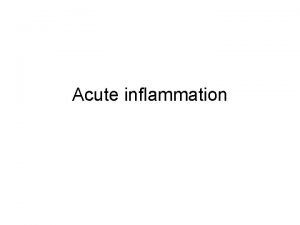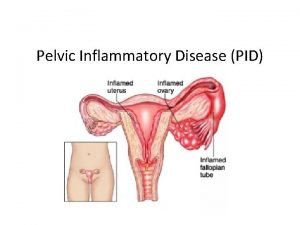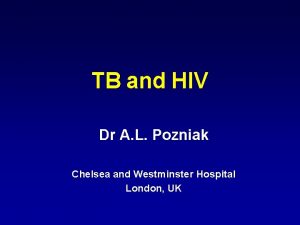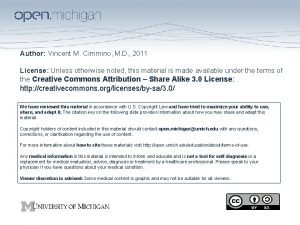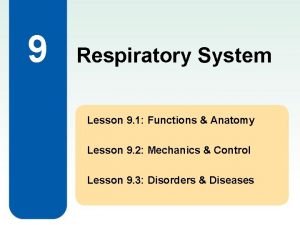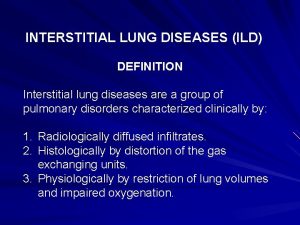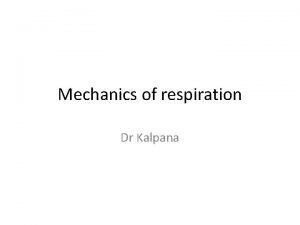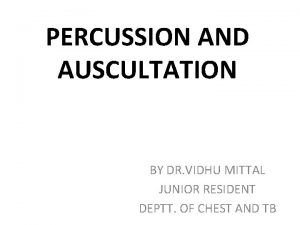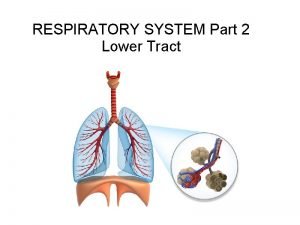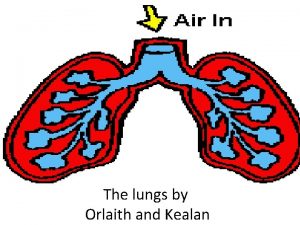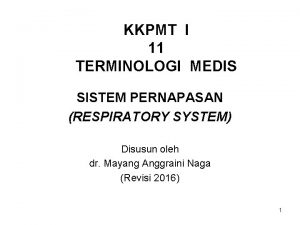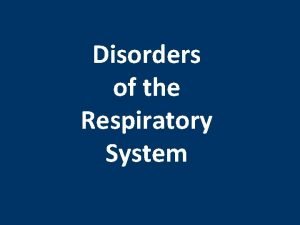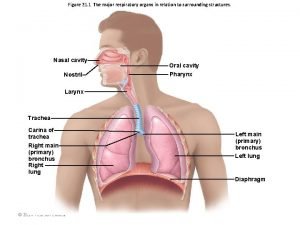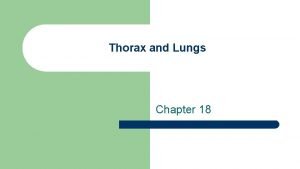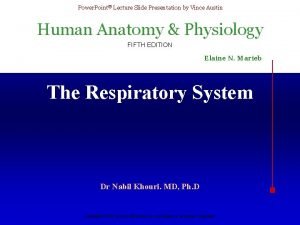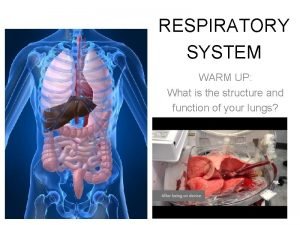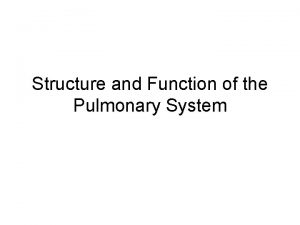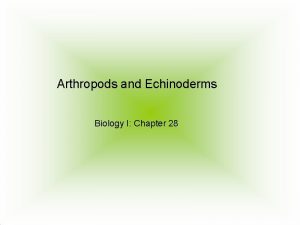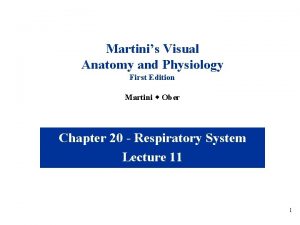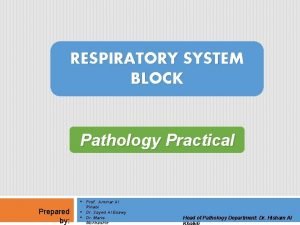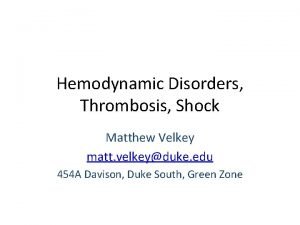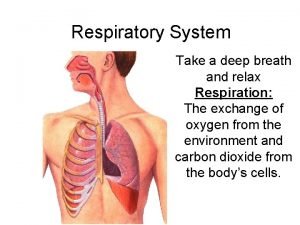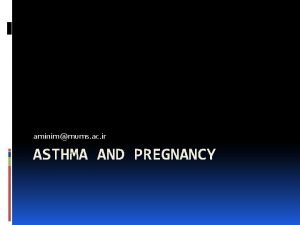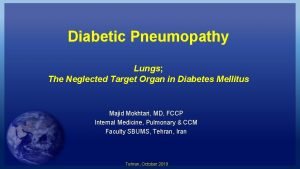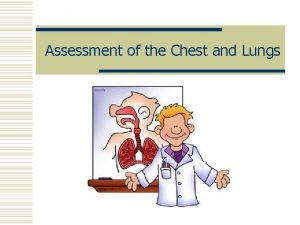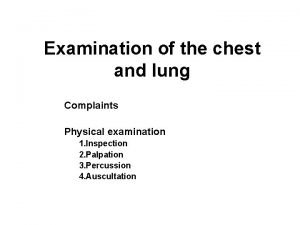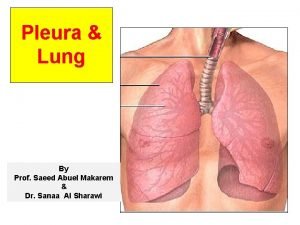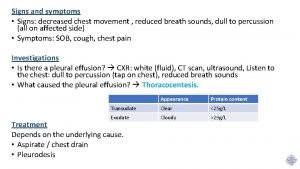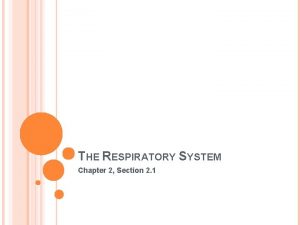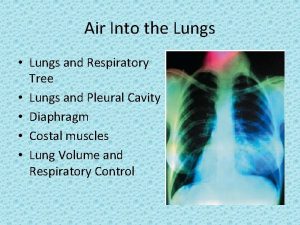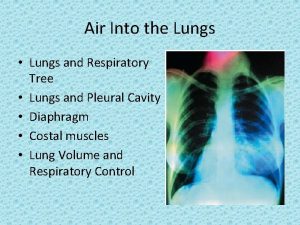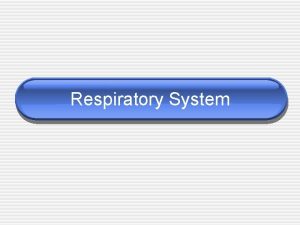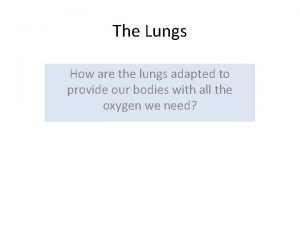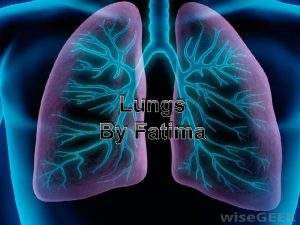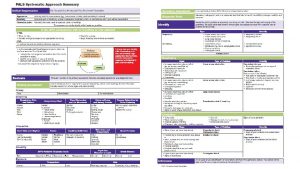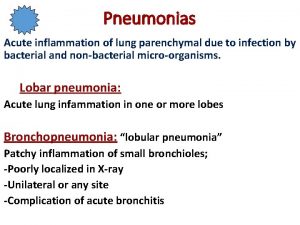ACUTE INFLAMMATORY DESEASES OF LUNGS PNEUMONIAS ACUTE DESTRUCTIVE






















































- Slides: 54

ACUTE INFLAMMATORY DESEASES OF LUNGS : PNEUMONIAS; ACUTE DESTRUCTIVE PROCESSES IN LUNGS. ACUTE RESPIRATORY VIRAL INFECTIONS. INFLUENZA. MEASLES.

PNEUMONIA is a group of diseases, characterized by acute inflammation of RESPIRATORY PART of LUNG.

CLASSIFICATION I. According to nosology characteristic : 1. Primary (is independent nosology form) 2. Secondary (is as complication of another disease). 3. Nosocomial (hospital-acquired) pneumonia.

II. According to etiology : 1. Viral infections. 2. Bacterial infections. 3. Fungi infections. 4. Protozoa. 5. Physical agents (radiation, dusty ). 6. Chemistry agents ( uremic, lipid ) and other.

III. Clinical – anatomic classification : 1. Lobar pneumonia. 2. Bronchopneumonia. 3. Interstitial pneumonia.

PRIMARY PNEUMONIA is independent nosologic form. It may be in cases : 1. LOBAR PNEUMONIA. 2. PNEUMONIA IN INFANT OF FIRST YEAR LIFE. 3. PNEUMONIA IN OLD-AGED PATIENT. 4. PNEUMONIA IN PATIENT WITH CHRONIC ALCOHOLISM OR NARCOMANIA.

LOBAR PNEUMONIA Synonyms: 1. Lobar pneumonia – the whole lobe is involved. 2. Croupous pneumonia (as a type of Fibrinous inflammation) 3. Fibrinous Pneumonia. 4. Pleuropneumonia – pleura is involved.

LOBAR PNEUMONIA – is an acute allergic-infectious disease, characterized by fibrinous inflammation affecting one lobe or several lobes of the lung and pleura, which covers this lobe. LOBAR PNEUMONIA it is always an independent disease, primary pneumonia.

ETIOLOGY : 1. Pneumococcus of I – IY types (usually), 2. Klebsiella pneumoniae (diplococcus Friedlaender). (rarely).

PATHOGENESIS: It is caused by hypersensitivity reaction induced by pneumococci or Klebsiella with immunocomplex disorders of microcirculation. Fibrinous inflammation is primary localized in alveolar tissue and not in bronchi. This fibrinous exudates spread for the whole lobe from pore of interalveolar septum rapidly.

Traditionally LOBAR PNEUMONIA is separated into 4 stages : 1. Initial stage or INFLUX (CONGESTIONS) 2. Stage of RED HEPATISATION. 3. Stage of GRAY HEPATISATION. 4. Stage of RESOLUTION.

INFLUX (CONGESTIONS) Microscopically it characterized by significant hyperemia & bacterial edema of involved lobe. Serous exudates with many bacteria occur in the alveoli. Capillary permeability is increased. It leads to exit of erythrocytes into the lumen of alveoli – erythrocytes diapedesis. Grossly: the lung is enlarged, firm, red, fill with fluid, which exudes from the cut surface. Duration of the 1 -st stage is about 1 day.

INFLUX (CONGESTIONS)

RED HEPATISATION. Microscopically: Erythrocytes diapedesis is prominent. Alveolar spaces are airless, filled with erythrocytes, fibrin & some of neutrophils. Grossly: the lung lobe is red, of liver-like consistency, enlarged. Pleural surface is covered by fibrinous exudate. Duration of this stage is 2 – 3 days.

RED HEPATISATION.

GRAY HEPATISATIO N The alveolar spaces are airless, contain a lot of exudates, which is composed of fibrin, neutrophils & macrophages.

GRAY HEPATISATION Pleura is thickened with fibrin & neutrophils infiltration.

GRAY HEPATISATION Grossly: The affected lobe of lung is enlarged, heavy, liver density, dry, gray. Pleura is thickened, with gray fibrinous films on the surface. Duration of this stage is 4 – 8 days.

RESOLUTION. Exudate within the alveoli is enzymatically digested and resorbed by macrophages and neutrophils or expectorated, leaving the basic architecture of lung intact. Duration of this stage is 9 – 11 days.

ATYPICAL FORMS OF CRUPOUS PNEUMONIA 1. CENTRAL PNEUMONIA 2. MIGRATORY PNEUMONIA 3. TOTAL PNEUMONIA 4. MASSIVE PNEUMONIA 5. FRIEDLANDER’s PNEUMONIA

CENTRAL PNEUMONIA – involving only the central part of the lobe, will be without fibrinous pleuritis. MIGRATORY PNEUMONIA – characterized by development of pneumonia in one lobe, than – in another and in the different lobes will be different stages. TOTAL PNEUMONIA – characterized by affection all lobes of lung.

MASSIVE PNEUMONIA – characterized by high rapidity development of inflammation with massive exudation. Fibrinous exudate fills with the lumen of bronchi. FRIEDLANDER’s PNEUMONIA, which affects exhausted and weak persons, or alcoholics. It characterized by severe course with prominent intoxication and empyema of pleura with rapid abscess formation. Several lobes are involved, predominantly are involved upper lobes of both lungs. The disease is resistant to antibacterial treatment.

OUTCOME OF CRUPOUS PNEUMONIA : 1. RESORPTION OF EXUDATE & RECOVERY. 2. CARNIFICATION ( it is organisation of the exudates within alveolar space )

COMPLICATIONS of CRUPOYS PNEUMONIA are divided into PULMONARY and EXTRAPULMONARY COMPLICATIONS are connected with proteolytic disfunction of neutrophils. 1. CARNIFICATION – are connected with insufficient proteolytic activity. 2. ABSCESS formation – are connected with increased proteolytic activity. 3. GANGRENE of the lung. 4. EMPYEMA of PLEURA.

ABSCESS formation CARNIFICATION

EXTRAPULMONARY COMPLYCATIONS are connected with generalization of infection by lymphogenic or hematogenic pathways : 1. PURULENT MEDIASTENITIS. 2. PERICARDITIS 3. PERITONITIS 4. PURULENT MENINGITIS 5. METASTATIC ABSCESS IN BRAIN 6. POLYPOID – ULCERATIVE ENDOCARDITIS 7. PURULENT ARTRITIS.

CAUSES OF DEATH : 1. HEART INSUFFICIENCY 2. LUNG INSUFFICIENCY 3. COMPLICATIONS (such as meningitis, brain abscess)

BRONCHOPNEUMONIA ( synonyme – LOCAL PNEUMONIA ) BRONCHOPNEUMONIA – is an acute local inflammation of lungs resulting from acute bronchitis or bronchiolitis. As usually it is secondary pneumonia, develops as a complication of some other diseases : Viral respiratory diseases, Myocardial infarction, Stroke, Tumors and other.

ETIOLOGY : A lot of microbiologic agents, chemical, physical factors are able to cause the disease. 1. VIRAL INFECTION: influenza, corona viral, parainfluenza, measles, respiratorysyncytial infection, adenoviral infection and other. 2. BACTERIAL INFECTION : pneumococcus, streptococcus, staphylococcus, pseudomonas aeruginosa, Escherichia coli, Enterobacter and other.

3. Fungal infections. 4. Mycoplasma. 5. PROTOZOAN infections. 6. MIXED infections. 7. Physical & chemical agents (uremic, lipid, dusty, radiation pneumonia).

Bronchopneumonia can involve one lung or both, & it commonly appears in posterior or basal segments : II, VIII, IX, X. The foci of pneumonia are of different sizes, as usually of 1 – 3 cm in diameter, firm, gray or white or gray-reddish colored and prominent on the cross – section.

Classification of LOCAL PNEUMONIA according to amount of foci inflammation : 1. Miliary (involving several alveoles) 2. Acinar (occupy acinus ) 3. Lobular 4. Multilobular 5. Segmental 6. Polysegmental 7. Subtotal 8. Bilateral.

Type of inflammation depending on the etiology of pneumonia & has some specific difference. According to the type of inflammation, pneumonia is divided into : 1. Serous 2. Fibrinous 3. Purulent 4. Hemorrhagic 5. Rotten

bronchus Exudate fills with the lumen of bronchi. Adjacent alveolar spaces are airless, fills with exudates. Allocation of exudates is irregular. In some alveoli there a lot of exudate, in other, one is a little. Cell infiltration also is present in interstitial tissue.

VIRAL PNEUMONII are usually serous, serous – desquamative or serous – hemorrhagic Serous – hemorrhagic pneumonia is in case of influenza. Viral pneumonia characterized by acute circulatory disorders, which appear as venous crisis with intraalveolar and interstitial edema. Exudate contains macrophages and some specific cells.

ADENOVIRAL PNEUMONIA : Giant mononuclear adenoviral cells in the exudate.

RESPIRATORY – SYNCYTIAL PNEUMONIA : Growing of the epithelial cells with giant multinuclear cells formation (like simplest) in the bronchi and into alveoli.

PARAINFLUENZA PNEUMONIA : Proliferation of the epithelial cells in the bronchi. (like “pillow”).

TRACHEA & LUNG WITH INFLUENZA (GRIPPE) Trachea and bronchi is covered with catarrhal or hemorrhagic exudates. Mucous membrane is hyperemic with multiple petecchii. The lung is enlarged, mottled, of nonuniform density and airless of grey red color. It is so-called “THE LARGE MOTTLED LUNGS”

n. COV 19

VIRAL PNEUMONII (especially n. COV 19, INFLUENZA PNEUMONIA) have some special features. The surface of alveoli is covered by so called HYALIN MEMBRANES, which are composed of fibrin condensate.

STAPHILOCOCCAL PNEUMONIA is the most severe type of the disease. Very often it is nosocomial pneumonia. It is always accompanied by necrosis, abscess formation and empyema of the pleura. Prominent edema and hemorrhage are also very characteristic for this type. Staphylococcal pneumonia is very resistant to antibacterial treatment.

BACTERIAL PNEUMONII are usually PURULENT.

PNEUMOCOCCAL PNEUMONIA. N. B ! Pneumococcal pneumonia may be : 1. LOBAR (CRUPOUS) PNEUMONIA ( 1 – 4 types pneumococcus) and 2. LOCAL (BRONCHOPNEUMONIA ) – other types pneumococcus. PNEUMOCOCCAL BRONCHOPNEUMONIA characterized by fibrinous inflammation. Exudate contains neutrophils and fibrin.

OUTCOMES of BRONCHOPNEUMONIA : 1. CONVALESCENCE with complete restitution and restore of the function. 2. CARNIFICATION. 3. PNEUMOSCLEROSIS

COMPLICATIONS

ABSCESS FORMATION.

GANGRENE

CARNIFICATION

PLEURITIS

INTERSTITIAL PNEUMONIA (Synonyms: PNEUMONITIS, PULMONITIS, ALVEOLITIS) - is characterized by primary acute inflammation within interstitium of respiratory regions & within alveolar septa with secondary exudation into alveolar space.

ETIOLOGY : 1. VIRAL INFECTION 2. MICOPLASMA 3. PNEUMOCYSTIS CARINI 4. LEGIONELLA PNEUMOPHILIA 5. FUNGAL INFECTION and other.

TYPES of INTERSTITIAL PNEUMONIA 1. PERIBRONCHIAL 2. INTERLOBULAR 3. INTERALVEOLAR

OUTCOME OF ITERSTITIAL PNEUMONIA DIFFUSE PNEUMOSCLEROSIS
 Pus smear
Pus smear Pelvic inflammatory disease
Pelvic inflammatory disease Odontogenic inflammatory diseases of maxillofacial area
Odontogenic inflammatory diseases of maxillofacial area Immune reconstitution inflammatory syndrome
Immune reconstitution inflammatory syndrome Pro and anti inflammatory
Pro and anti inflammatory Inflammatory breast cancer pictures
Inflammatory breast cancer pictures Predeksihkhariini
Predeksihkhariini Desquamative inflammatory vaginitis
Desquamative inflammatory vaginitis Inflammatory cells
Inflammatory cells Treatment of inflammatory breast cancer
Treatment of inflammatory breast cancer Pelvic inflammatory disease men
Pelvic inflammatory disease men Mechanical vs inflammatory pain
Mechanical vs inflammatory pain Types of colitis
Types of colitis Paul charlson
Paul charlson Lungs animal
Lungs animal Lesson 9.1: the anatomy of the lungs
Lesson 9.1: the anatomy of the lungs Reticonodular
Reticonodular Lung compliance meaning
Lung compliance meaning Succussion splash
Succussion splash Gas exchange in circulatory system
Gas exchange in circulatory system Lungs 3 lobes
Lungs 3 lobes Aesses
Aesses Istilah medis sistem pernapasan
Istilah medis sistem pernapasan Wwf
Wwf Nervous tissue in the lungs
Nervous tissue in the lungs Lungs blue
Lungs blue Vertebral cavity
Vertebral cavity Lobes of lung
Lobes of lung Pleura
Pleura Tactile fremitus pleural effusion
Tactile fremitus pleural effusion Lobes and fissures of lungs
Lobes and fissures of lungs Lungs 3 lobes
Lungs 3 lobes Breath sounds location
Breath sounds location Homeostatic responses to respiratory acidosis
Homeostatic responses to respiratory acidosis Diaphragmatic impression
Diaphragmatic impression Arthropods and echinoderms
Arthropods and echinoderms Lungs excretory function
Lungs excretory function Bronchial tree
Bronchial tree Barotrauma sprayer
Barotrauma sprayer Dohányos tüdő
Dohányos tüdő Conducting zone lungs
Conducting zone lungs Acute pulmonary congestion histology
Acute pulmonary congestion histology Apices of lungs
Apices of lungs Respirator system
Respirator system Ziluten
Ziluten Lungs blue
Lungs blue Tactile fremitus location
Tactile fremitus location Diaphragm percussion
Diaphragm percussion Tetralogy of fallot murmur
Tetralogy of fallot murmur Bronchial segments
Bronchial segments What causes lungs pain
What causes lungs pain Breathing mechanism
Breathing mechanism Function of lungs
Function of lungs Lungs marijuana
Lungs marijuana No repto tho
No repto tho
